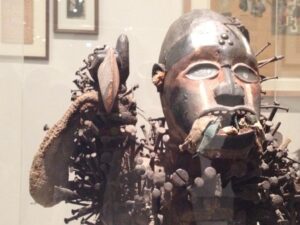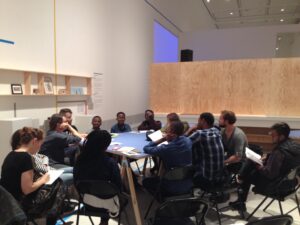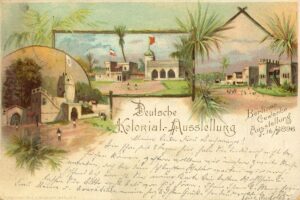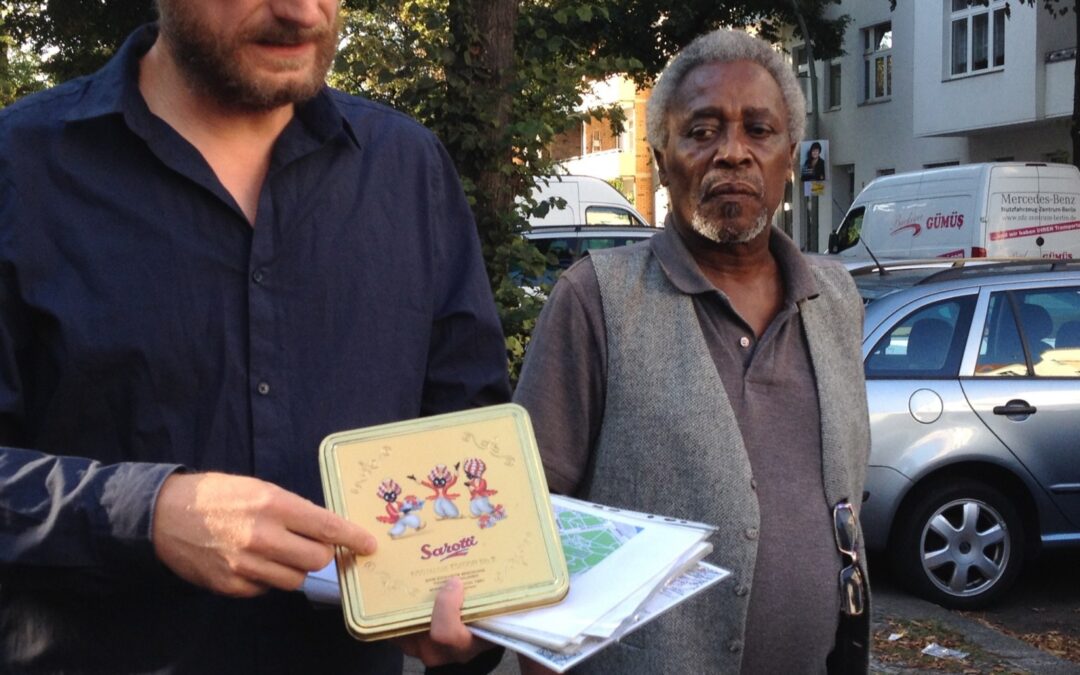WEEK 2 – AFRICA IN BERLIN
Visions of Africa through Art
The first day of this second week was dedicated to visiting the exhibition Dada Afrika, curated at the Berlinische Galerie. Here is an excerpt from the companion reader for the pieces:
Marking the centenary of the Dada movement, this is the first exhibition about Dada’s response to non-European cultures and their art. Five sections display Dada works in a dialogue with works from Africa, Asia, North America and Oceania. In the midst of the First World War, a group of artists came together in 1916 under the random title “Dada” to resist a bourgeois Western culture. This, in the eyes of the Dadaists, had lost all credibility. Dada set out to “negate the ‘meaning’ of life to which Europe has so far subscribed”. Its artists radically questioned the inherited values of their own cultural setting. The Other seemed to offer an attractive alternative, a foundation for devising entirely new forms of articulation. Dada pictures and masks were inspired, for example, by African artefacts. Costumes worn at Dada soirées drew on designs by native peoples of North America, and Dadaist assemblage revealed Oceanic influences. In the literary field too, Dada poems took their cues from African and Australian texts.
The full reader is available online in English and in German.

Some of the Tanzanian students, upon first seeing the title of the exhibition, assumed it would be collections of purely African art –since in Swahili, “dada” means sister –the exhibition thus could have been about “sister Africa”. But the introduction commentaries immediately situated the curation from a very occidental standpoint, using vocabulary like “the Other” without further explaining it.
 We discussed such sessions in a roundtable workshop at the end of the visit. Students commented that the exhibition was disconcerting since it only focused on the art pieces for their formal qualities, rather than trying to depict a way of life, stories or techniques, that actually represented African art as a real practice. This remote and observatory interest recalls, in a way, the categorisation of all types of non-western pieces as “art nègre” during colonial times –putting Asian, African, Native American and Aboriginal artists in the same category, sometimes seen as primitive. These are the kinds of connotations that immediately sprung up upon seeing the term “the other”.
We discussed such sessions in a roundtable workshop at the end of the visit. Students commented that the exhibition was disconcerting since it only focused on the art pieces for their formal qualities, rather than trying to depict a way of life, stories or techniques, that actually represented African art as a real practice. This remote and observatory interest recalls, in a way, the categorisation of all types of non-western pieces as “art nègre” during colonial times –putting Asian, African, Native American and Aboriginal artists in the same category, sometimes seen as primitive. These are the kinds of connotations that immediately sprung up upon seeing the term “the other”.
In the same line of thought, the visit was also startling for how abstract and “white-box” the exhibition space was, denying any sort of historical and social connexions that could help contextualise the artists and their pieces. As one student put it, the collections are “like a balloon floating in the 1910s and 1920s, disconnected from history and impossible to relate to, other than for its plastics. We have no idea how they were made or who the original artists were”.
Some of the pieces themselves, like the early collages from Hannah Höch (who was one of the first artists to experiment with this technique), talked about the way African art was accessed at the time: through museums, or through gallery publishings. The artist, in fact, would take pictures from art magazines to make her collages. No other relations with Africa were mentioned in the reader, which was again puzzling for its lack of clarity regarding colonial histories and the way they impacted people’s vision of Africa.
Finding Africa in Berlin
Students were asked to conduct fieldwork in various areas of Berlin to encounter, beyond the polished spaces of museums, the current interconnexions of Africa in Berlin’s urban spaces. Some opted for cultural and social spaces like the YAAM – Young African Art Market, which has become a place for finding food, art and clothes from all over Africa, along with regulars hanging out in the sandy garden and listening to reggae. Other opted to go to the Afro-shops of Neukölln, mostly found on Sonnenallee and around Hermannplatz. A useful reference was ExBerliner’s two-part article entitled “Africans in Berlin”, which directed another group of students to the International Christian Revival Church in Wedding. Find the assignments for the summer school here.
Tour of the Afrikanische Viertel in Wedding
In the late afternoon, we welcomed another input from the NGO Berlin Postkolonial. Another post was made about a previous tour in May 2016. This time, even more emphasis was put on the current and very real testimonies of German colonial politics in the city of Berlin –beyond symbolic street names like Wissman, Gröben and Luderitz. In fact, as described by Christian Kopp, the founder of Berlin Postkolonial, looking at urban planning history indicates how significant the relation was with African colonies.

Kunstanstalt J. Miesler, Berlin S. – Deutschland in alten Ansichten DVD-ROM
old picture postcard of Berlin industrial exhibition 1896 in Treptower Park – view of the colonial exhibition
For instance, Rehberge Park, in the Afrikanische Viertel, was planned as the exhibition ground for the Deutsche Colonial-Ausstellung, including a “human zoo” featuring 400 men and women from Africa “in their natural habitat” (reconstructed hut villages and imported plants). While Rehberge Park presented a better topography and general climate to reproduce certain features of African landscapes, it was decided that the exhibition would be held at Treptower Park, in the context of the 1896 Berliner Gewerbeausstellung (Industrial Exhibition) which aimed to compete with other European empires at the time, particularly with France’s 1889 Exposition Universelle which showcased its industrial prowesses… as well as a colonial exhibition with “human zoo”.
All in all, the second week of the summer school focused on finding “overlaps” between German and Tanzanian history, against the common assumption that these two countries have little assumption. Using different disciplines –art criticism, ethnography, political activism– students have begun to draw new lines between the narratives collected in Berlin and Dar es Salaam.

